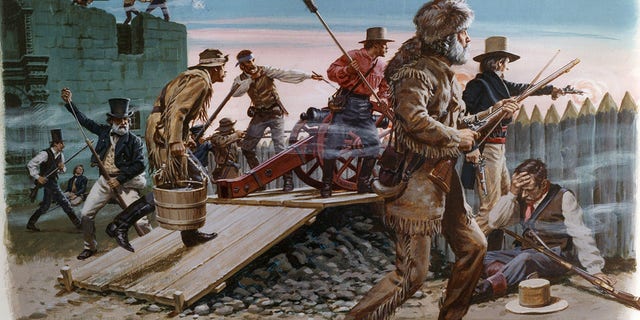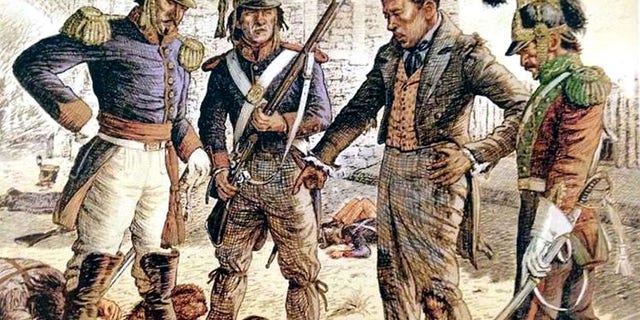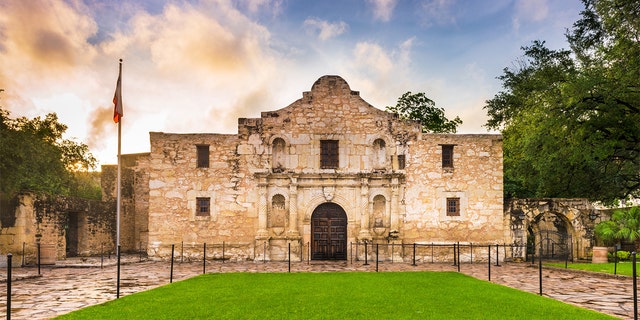Texas remembers the Alamo every March. Here are 10 things you may not know about the Lone Star State’s history
On March 2nd, 1836, settlers in Mexican Texas signed the Texas Declaration of Independence, creating the Republic of Texas. They just had to win the war they had been fighting to make the declaration stick. The odds were very much against them.
The Alamo in San Antonio, surrounded by a much larger Mexican force at the time, fell four days later. All the defenders inside including David Crockett, James Bowie, and William Barret Travis, either died during the siege and battle, or were executed immediately afterward. Their bodies were piled up outside the fortress and burned. The Texan fortress at Goliad fell to Mexican forces on March 27, and like the Alamo, all of its defenders either died in the battle or were executed. Yet Texas won its independence from Mexico in one of the most improbable and consequential battles in world history on April 21, 1836, at San Jacinto.
To commemorate the 187th anniversary of the Texas Revolution, here are ten things you may not have known about the Alamo, Texas, and its war for independence.
1. Mexico should have won
By all accounts Texas’ revolt should have been an easy sweep for the Mexicans. The Texians (as they were called at the time) had charismatic leaders but were disorganized. In 1835 Mexican Presidente Antonio López de Santa Anna, a war hero himself, invaded the rebellious province with a massive army of some 6,500 men, outnumbering the about Texans 3-1. With this he won two crushing victories against the Texans at the Alamo and Goliad. However, Santa Anna then foolishly split his army into three parts. The detachment he led was defeated at San Jacinto by Sam Houston, Santa Anna was captured alive, and in exchange for his life he ordered his other generals to leave Texas. Without this miraculous series of lucky breaks the Mexican army almost certainly would have put down the Texas revolution as it had previous revolutions.
2. The Alamo started out as a church and could have been destroyed before there ever was a famous battle
One of the most legendary battles in history, the Battle of the Alamo has captured the public’s imagination since shortly after its brutal conclusion. Jim Bowie’s famous knife became the must-have frontier tool for working and self-defense. However, the brave defenders could have been elsewhere. In early 1836, General Sam Houston gave orders to Jim Bowie: report to the Alamo, destroy it, round up the Texans there, and fall back east. Bowie, when he saw the Alamo and consulted with its on-site commander, decided to defend it instead. The rest is history. Bowie would eventually share command of the Alamo with Col. William Barret Travis.
The Alamo itself was originally a Catholic mission called Mission San Antonio de Valero. It was established in 1718 on a different site from the present Alamo. After moving to the present site in 1724 and serving as a church and mission for several decades, it was deconsecrated and used for various things, including as a fortress to help defend the city of San Antonio. The Texans and Tejanos actually took the Alamo from the Mexican forces in late 1835 in the Battle of Bexar, setting up the famous battle a few months later.

3. Fighting started over a cannon…or the right to bear arms
Tensions had been building since at least 1832, when a Mexican force was sent to Nacogdoches to confiscate the guns from the citizens living there. The Texans refused to surrender their firearms, won that battle, and tensions simmered until they boiled over at Gonzales three years later.
The Mexicans had left a small cannon in the town of Gonzalez for purpose of warding off Native American attacks. Sensing a revolt could be imminent the Mexicans sent a detachment of 100 horsemen under Lieutenant Francisco de Castañedato to take the cannon in October 1835. When Castañedato arrived at Gonzalez, he found the city in open defiance, daring him to “Come and Take It.” After a small skirmish on Oct. 2, Castañedato retreated and the Texas War for Independence was on.
ON THIS DAY IN HISTORY, DEC. 29, 1845, TEXAS JOINS UNION AS 28TH STATE AFTER WINNING INDEPENDENCE FROM MEXICO
4. Mexicans fought alongside Texans
While the war was primarily fought between American settlers and the Mexican government, Texas y Coahuila was a Mexican state and there were plenty of native Mexicans in the region. These Mexicans native to Texas, called Tejanos, were angry with Mexico’s neglect of the region and Santa Anna’s Centralist, and sometimes brutal government – and many thought they would be better served as an independent nation than a neglected province ruled from far away. They by and large supported the Federalists. Three Tejanos signed Texas’ Declaration of Independence and Tejano soldiers fought bravely at the Alamo and elsewhere. One of the defenders, Jose Toribio Losoya, was born at, grew up at, and died at the Alamo fighting against Santa Anna.
5. The Texans mostly ran away after the Alamo
Following in the footsteps of George Washington, Houston employed a strategy known as the “Runaway Scrape.” After the massacres at the Alamo and Goliad thousands of Texas settlers began fleeing eastward. The newly-formed Texas army, unable to stand and fight against the Mexicans, mostly retreated with the civilians, burning crops and resource depots along the way. This was to lure Santa Anna deeper into enemy territory until Houston could find an opportunity to defeat him, an opportunity that came at San Jacinto.
6. The Battle of San Jacinto was one of the most lopsided battles in history
In April 1836, Mexican General Santa Anna was chasing Sam Houston into eastern Texas. On April 19 Houston found a spot he liked and set up camp. Santa Anna arrived shortly thereafter and set up camp nearby. Houston launched an all-out assault at the unlikely time of 3:30 in the afternoon. The Mexicans were taken completely by surprise with the best Mexican officers dying in the first wave. Fleeing Mexican soldiers found themselves pinned up against a river and the Texans, enraged after the massacres at the Alamo and Goliad, gave no quarter. The final tally: 630 Mexicans dead and 730 captured, including Santa Anna. Only nine Texans died.

7. The war was fought over a political power grab – and Santa Anna’s treachery
The American Revolution and its radical view on inalienable human rights endowed by a Creator was sweeping across the world when Texas was still a part of the Spanish Empire and then Mexico. Once Mexico achieved independence from Spain, an argument arose over what kind of nation it would be. Two camps squared off: the Federalists and the Centralists. The Federalists sought an American-style government in which the states held most of the political power. The Centralists favored a much stronger central government, along the lines of Napoleon Bonaparte’s dictatorship in France. War hero Santa Anna himself had first sided with the Federalists, but switched to the Centralists and abolished local and state legislative power once he became president – and styled himself the “Napoleon of the West.” He ruthlessly crushed a Liberal rebellion in the Mexican state of Zacatecas in 1835, the first of his several massacres. The Texans and Tejanos favored Federalism, and rebelled (along with Mexicans in several other states that wanted Federalist governance) against Santa Anna’s heavy-handed rule. Many of the Texans, such as Sam Houston and David Crockett, were either children or grandchildren of the American revolutionaries. They were not about to give in to dictatorship.
Slavery was also a factor in the Texas Revolution, but not its ideological root cause. Sam Houston owned slaves but opposed its expansion, and later fought to keep Texas from siding with the Confederacy. Stephen F. Austin was more ambivalent. Mexico had outlawed slavery in some states, but allowed it in Texas. Peonage still existed in Mexico. An abolitionist, Dr. Amos Pollard, was among the Alamo Defenders who perished when the fortress was put to the sword on March 6, 1836. He had written letters to American abolitionist leaders hoping to persuade more like-minded people to move to Texas and make it a republic free from slavery.
8. Texas was once bigger
During its period as an independent country, Texas’ borders spread across much more territory than today – even up into present-day Wyoming. The republic and later state was land-rich but cash-poor. Even after joining the United States, Texas held on to the idea that it would take a large chunk of the Territory of New Mexico. But as part of the Compromise of 1850, which maintained the balance of power between free and slave states, it relinquished claims to roughly 67 million acres in exchange for $10 million to pay off its debt.
MEET THE AMERICAN WHO FOUGHT AND BLED AT THE ALAMO BUT LIVED TO TELL ITS HEROIC TALE: SLAVE JOE

9. It led directly to the Mexican-American War
For nine years, Texas remained an independent nation, fighting off the occasional invasion by Mexico intending to reclaim it. Meanwhile, Mexico did not recognize Texas and repeatedly stated that if Texas joined the USA, it would be an act of war. In 1845, Texas was annexed to the USA and Mexico was furious. When the U.S. and Mexico both sent troops to the border region in 1846, a conflict became inevitable: the result was the Mexican-American War.
10. The revolution was a political comeback for Sam Houston
In 1828, Sam Houston was a rising political star. A protégé of popular president Andrew Jackson, Houston had already served in Congress and as Governor of Tennessee. Then in 1829, it all came crashing down. A failed marriage led to full-blown alcoholism and fall from grace. Houston went to Texas where he was eventually promoted to commander of all Texan forces. He later served as President of Texas and after Texas was admitted to the USA he served as senator and governor. In his later years, Houston became a great statesman: his final act as governor in 1861 was to be deposed in protest of Texas’ joining the Confederate States of America. He had fought to make Texas a state for years, believed that the south would lose the Civil War, and that Texas would suffer for it.
Read the full article Here


